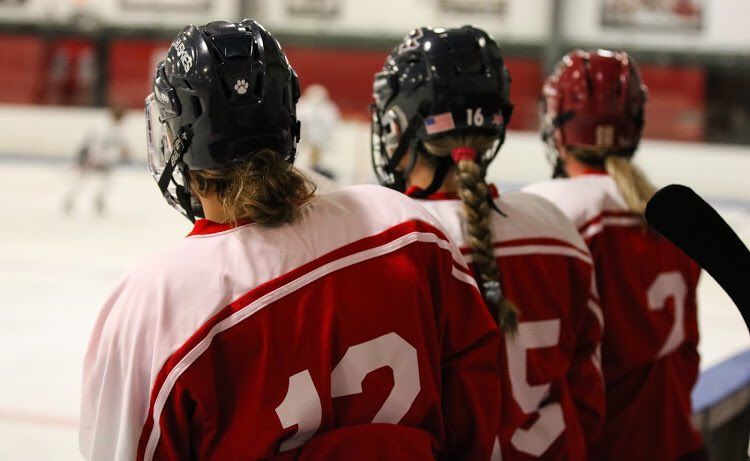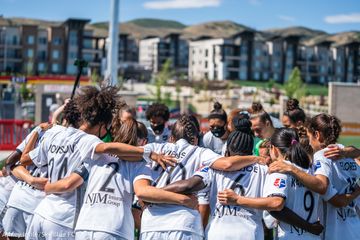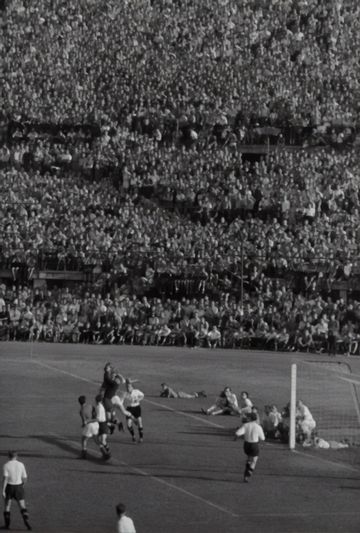Restricted to contained settings in Utah, Florida, and cities across North America, athletes in numerous sports have begun returning to competition. And in Hudson, New Hampshire, in recent weeks, women's hockey players have quietly taken to the ice.
Announced on March 9, 2020, the Elite Women's Summer Hockey League opened on June 18, hosting some of the first elite team-sport athletes to return to play in North America. As a localized off-season series, it has not confined players to a bubble or tested them for COVID-19. With rosters ranging from recent high school grads to college stars and Olympic medalists, the EWSHL is streaming high-calibre hockey at a time when little else is being broadcast. And in a sports landscape dominated by discussion of return-to-play plans, it's gone largely unremarked upon.
Robert Morris University's women's hockey team had just wrapped up its season when the COVID-19 pandemic shut down sports across North America in March. It was an interruption that was particularly challenging for many student-athletes who saw promising campaigns cut short, or faced a premature ending to their college careers. But in some ways, the forced break it imposed also came as a relief.
"I think everyone was kind of enjoying the rest," admitted RMU redshirt junior Michaela Boyle, who pointed out that some teams typically give their athletes just a week or two off before implementing mandatory spring training programs. "I feel like most people thought that it would kind of be a one-month thing and then we'd be done, and here we are almost four months later still dealing with this pandemic. It's been a tough adjustment."
As it became clear that workouts would have to resume independently, Boyle, whose dad is a prominent strength and conditioning coach, had some level of advantage. When non-essential businesses were ordered to close, she and her family scavenged equipment from the gym and set up a makeshift training center in the garage. She spent the spring mornings training alongside her younger brother and best friend Cayla Barnes, who moved in for the summer. But for someone who's used to being back on the ice by early May, the lack of rink access was a major change.
A five-year veteran of the postgrad circuits, Erin Kickham is used to seeking out ice where she can find it and fitting her training around a full-time work schedule. As a pediatric nurse practitioner, she's been even busier since the pandemic took hold. With rinks and fitness facilities closed, she's put together a miniature home gym in the basement, where she's kept active through self-crafted circuits and Zoom workouts. And while rink closures have certainly impacted her training, access to facilities has hardly been the only thing limiting her ice time.
"I'd love to skate more," she said. "But more for my job it's a little bit prohibitive to skate as much as I think I would ideally like to, just being in the nursing field right now."
So when the EWSHL came to fruition this summer, it presented a unique opportunity for athletes like Boyle and Kickham to get back on the ice.
Bill Flanagan, who owns Cyclones Arena, had hoped to get a summer league going last offseason, but things didn't quite come together in 2019. When he said that this year he'd start it "no matter what," though, he hadn't envisioned a pandemic. The initial plan for the EWSHL involved marketing, partnerships, and outreach. There were discussions with local girls' teams and conversations with prospective sponsors. Instead, the onsite crowd has been limited to one family member per athlete, and games are viewable exclusively through an online stream. Still, after gauging interest with players, launching the league remained a question of when and not if. Flanagan and colleagues managed to finalize logistics in a three-week span once state officials announced that sports could resume. For many athletes who'd been kept off ice far longer than usual, the league was an especially welcome opportunity.
"Honestly, I was just ready to be back playing," explained Boyle, who said that despite the pandemic, she didn't hesitate to join. "It felt like a part of me was kind of gone not being able to go skate, not being able to see my friends, do what I love… as soon as I heard about it, I jumped on it."
Occupying a hybrid space between a traditional league and a series of high-level pick-up games, the EWSHL has athletes register in advance, without strictly mandated attendance. As with everything in women's hockey, players are often balancing work commitments away from the rink. They sign in ahead of each game they can make and rosters are adjusted accordingly.
Athletes signed a health waiver prior to registering with with the EWSHL; when they sign in, players self-declare that they have no COVID-19 symptoms and, to the best of their knowledge, have not been in contact with anyone who does or who has tested positive. The arena is regularly disinfected, and sanitization efforts have been stepped up as a precaution. Coming in through a side door, athletes enter to a spread-out locker room with freshly cleaned jerseys and socks lined up in distanced stalls. For safety reasons, showers have been off-limits.
Ahead of the contests, which feature two 25-minute halves, players have access to a table of free essentials including tape, snacks, and laces. Despite the near-empty stands, there is a P.A. announcer onsite to announce scoring, with the aim of fostering a professionalized atmosphere. An athletic trainer and equipment manager are also on hand. That flows from the desire to provide high-level women's hockey players with something resembling the level of resources and attention they deserve. The league, after all, features such familiar names as U.S. Olympians Barnes, Alex Carpenter, Kali Flanagan, and Megan Keller, alongside rising stars like Katie Burt, Paige Capistran, and Sammy Davis.
Other top-level sports that have returned have largely done so in so-called bubbles, with restricted access to a centralized location. EWSHL players, in contrast, are not isolated and do not follow regular testing protocols. The league is, of course, a regional off-season circuit with a small cohort of players, which distinguishes it from other ongoing competitions. But the athletes taking the ice on Thursday nights in Hudson are among the best in the game. In that sense, it is perhaps most comparable to the recent softball series between the USSSA Pride and This Is Us, which was cancelled five games in due to COVID-19 exposure ― though that series was hosted in Florida in front of unmasked crowds. (It's worth noting that apart from the NHL, which recently selected Edmonton and Toronto as its hub cities, professional leagues have mainly placed their competition sites in COVID-19 hotspots.)
In New Hampshire, though, case rates are low and state officials have sanctioned a return to play at all levels. When it comes to playing sports in uncontained settings without frequent testing programs, the most important thing is for participants and those around them to understand that precautions can't end at the rink, according to USA Hockey chief medical and safety officer Dr. Michael Stuart. "We are trying to promote safety in the arena environment and amongst all the hockey personnel, but then you certainly don't want to leave practice, take your mask off, and get into a group of people, friends, or other activities outside of hockey, and then come back to the rink," explained Dr. Stuart, who also sits on the IIHF Medical Committee. "I would like to see these athletes practice these same principles we're promoting in a hockey environment in the rest of their daily life."
Kickham, while acknowledging that everyone is probably a little more hesitant in most aspects of life these days, said she had no major concerns about joining up.
"I think I'm coming from that healthcare background where I feel that people are hopefully taking all the necessary precautions that have been discussed, and that what people are doing outside of the rink is to keep themselves safe and healthy," she said. "I think people have been very understanding and safe and aware of all these recommendations. The girls that we're playing with, we want to keep playing, so I think everybody is trying to take all those necessary precautions."
Most of the recommended guidelines for amateur sports mirror instructions for day-to-day activities. Masks are encouraged in enclosed spaces, and physical distancing should be practiced off the field of play. Personal hygiene is paramount, with frequent hand washing and ready access to sanitizer. Venue surfaces and equipment should be diligently disinfected, and people should be screened through questioning ― and temperature checks, where feasible ― before entering the arena. When it comes to practices, USA Hockey has also designed a list of drills to facilitate the maintenance of physical distance on the ice. Very few of these measures, however, can be implemented during actual play.
As a small women's league, the EWSHL may be better placed to respect additional in-game precautions than many other organizations. While specific recommendations for competitive hockey have not been issued, certain adaptations may help reduce the risk of transmission. Dr. Stuart suggested 3-on-3 as an option to open the ice and spread things out; though the summer league is 5-on-5, its small rosters do provide for a shortened bench and less crowded off-ice areas. Eliminating body contact and bodychecking is another way to minimize exposure, which aligns more easily to the rules of women's hockey than men's. A further consideration points to equipment choices: full shields may provide an extra layer of protection, as opposed to cages. "Even though that full shield does not prevent inhalation of aerosolized droplets, it does create a barrier from droplets from getting on your face," Dr. Stuart explained.
In addition to the EWSHL, Flanagan runs daily summer skates for a group of elite players, mainly on the U.S. national team. Those started about six years ago, when his daughter Kali was playing at Boston College. As she got older and rose through the ranks, it became clear that competitive off-season options for women were limited, and both the skates and the league are an attempt to fill that gap. Players aren't charged to participate in the training or the games, and basic supplies are offered free-of-cost as well.
"I have the facility, and I'm dedicated because I've been around a lot of these women and see how hard they work and the dedication they put in," Flanagan said. "I'm in it to give them a better opportunity, whatever that might be. Whatever small way I can help out, that's what I'm doing."
Boyle has been partaking in the summer sessions for three years as one of a collection of athletes who practice in Hudson four days a week after mornings spent doing off-ice training at her dad's gym. "He wants to see us succeed," she says of Flanagan. "He pushes us harder than your average coach because he does care about the potential we have as female athletes and the potential we have to kind of change the way that women's hockey is going."
From a coaching perspective, Flanagan feels that five-on-five game situations are a valuable complement to skills training, particularly given the extended length of the women's hockey offseason. Boyle believes that's especially true in a year like this, where seasons ended prematurely and ice time has been in short supply. And athletes who want to stay in game shape have been taking it into their own hands for years. Even in her college days, Kickham recalls players pitching in their own money to rent ice and set up summer scrimmages. This is the first time she's seen an organized opportunity, let alone one that doesn't come with a bill.
As the weeks go by, Flanagan said they're seeing increased interest from players who'd like to suit up. If numbers warrant, he's able to accommodate two more teams into the fold. The schedule, currently slated to end on August 6, could also be extended. Through online streaming, the EWSHL hopes to further showcase its high-caliber hockey.
"As soon as the helmet's on and the puck's dropped, everyone just wants to win," said Boyle, adding that friendly teasing has carried over into the gym on Fridays. "With this league it's not like you're winning anything ― you're winning the game, but it's just a sense of pride. I think that just shows the level of competition. Your best friend could be on the other team, but it doesn't matter because in that moment, you want to win."
Flanagan hopes that when it's deemed safe, the league can also welcome the local community and give young girls a chance to see top players up close. But even if the EWSHL is unable to implement its full vision, the option to compete at all during the offseason is something that's been missing from the local women's hockey landscape.
"Until this league was created, there wasn't really another high level of competition game out there for girls," Boyle said. "I think that there was such a void when it came to giving the girls the ability to showcase their talent and to get games during the summer."
(Photo credit: Ricky Wilson)



